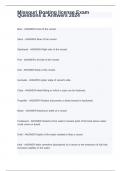-
1. Exam (elaborations) - Missouri state exam questions and answers 100% accurate
-
2. Exam (elaborations) - Civics exam (missouri)questions and answers 100% correct
-
3. Exam (elaborations) - Missouri test exam questions & answers(rated a)
-
4. Exam (elaborations) - Missouri state test questions and answers(graded a)
-
5. Exam (elaborations) - Life and health insurance exam (missouri) questions and answers(scored a)
-
6. Exam (elaborations) - Missouri state exam simulator - 145 questions weighted exam, missouri life and health...
-
7. Exam (elaborations) - Missouri life insurance exam questions with grade a+ answers
-
8. Exam (elaborations) - Mo real estate exam practice with correct answers
-
9. Exam (elaborations) - Missouri constitution test exam question & answers 100% solved
-
10. Exam (elaborations) - Missouri government final exam with complete solutions!
-
11. Exam (elaborations) - Missouri life and health insurance exam questions and answers 100% correct
-
12. Exam (elaborations) - Missouri post test - 2020/2024 exam questions and answers 100% verified
-
13. Exam (elaborations) - Mo constitution test practice exam questions with already passed answers
-
14. Exam (elaborations) - Missouri life insurance exam questions & answers latest update
-
15. Exam (elaborations) - Missouri exam prep-licenses questions and answers 100% solved
-
16. Exam (elaborations) - Missouri life accident and health exams questions and answers
-
17. Exam (elaborations) - L1ma missouri exam questions and answers 100% verified
-
18. Exam (elaborations) - Missouri property and casualty insurance exam questions and answers
-
19. Exam (elaborations) - Final exam-missouri life and health with accurate answers
-
20. Exam (elaborations) - Study guide for the missouri state board exam questions with rationales answers
-
21. Exam (elaborations) - Real estate exam- missouri portion only questions and answers 100% correct
-
22. Exam (elaborations) - Missouri drivers exam questions & answers 100% accurate
-
23. Exam (elaborations) - Missouri real estate exam questions and answers 100% solved
-
24. Exam (elaborations) - Missouri life and health exam questions and answers(rated a)
-
25. Exam (elaborations) - Final missouri nursing home admin state test exam questions and answers
-
26. Exam (elaborations) - Missouri cna certification exam 2021/2024 questions and answers(graded a)
-
27. Exam (elaborations) - Examination for missouri insurance producer's license questions with accurate answers
-
28. Exam (elaborations) - Mo health and life insurance exam questions & answers(scored a)
-
29. Exam (elaborations) - History of missouri exam 1 questions and answers 100% correct
-
30. Exam (elaborations) - Missouri life accident and health insurance producer (op12-mo54) license exam questio...
-
31. Exam (elaborations) - 2022/2024 missouri civics exam questions and answers 100% verified
-
32. Exam (elaborations) - Missouri law exam per don otto class questions and answers 100% accurate
-
33. Exam (elaborations) - Missouri exam prep business conduct questions and answers
-
34. Exam (elaborations) - Missouri state nursing home administrator exam questions and answers
-
35. Exam (elaborations) - Mo state law for real estate salesperson exam questions and answers
-
36. Exam (elaborations) - Missouri funeral directors law exam with verified answers
-
37. Exam (elaborations) - Missouri post study guide exam with complete solutions!
-
38. Exam (elaborations) - Updated missouri administrators exam questions with graded a+ answers
-
39. Exam (elaborations) - Missouri boating license exam questions & answers 2024
-
40. Exam (elaborations) - Missouri driving test (including class e) questions and answers 100% accurate
-
41. Exam (elaborations) - State board for mo (written) exam questions and answers 100% solved
-
42. Exam (elaborations) - Real estate exam- mo & national study with complete solutions!!
-
43. Exam (elaborations) - 2020 missouri post test study guide with 100% solved answers
-
44. Exam (elaborations) - Missouri permit practice test exam questions and answers
-
45. Exam (elaborations) - State constitution exam: missouri questions with answers rated a+ correct
-
46. Exam (elaborations) - Missouri personal finance test (mopfa) exam questions and answers(graded a)
-
47. Exam (elaborations) - Missouri title producer exam title insurance terms questions and answers
-
48. Exam (elaborations) - Missouri content assessment (ss) exam questions and answers(scored a+)
-
49. Exam (elaborations) - Final exam - missouri life only with already passed answers
-
50. Exam (elaborations) - Missouri civics exam review 2023/2024 questions and answers latest update
-
51. Exam (elaborations) - Missouri higher education civics achievement examination questions & answers
-
52. Exam (elaborations) - Missouri p&c exam questions and answers 100% accurate
-
53. Exam (elaborations) - Civil exam (us & mo) exam questions and answers
-
54. Exam (elaborations) - Mo final exam with a+ grade answers
-
Show more




